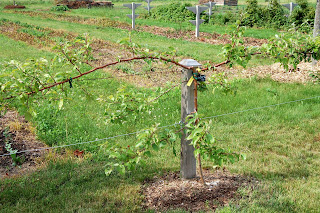Espalier Apples
The first time I ever saw an espalier apple fence was at Monet’s garden during my visit to France. The term Espalier refers to growing and training plants, in this case fruit trees, along a structure like a sunny wall or fence to create a living object. Monet was a pioneer in this growing technique and in the 1920’s planted his espalier apple fence. Since my visit there, I planted my own apple fence on the farm and quite enjoy it.

The best fruit trees to grow in this manner are pears and apples as they lend themselves well to vigorous pruning and are available in smaller varieties. There are also a couple advantages with this method. Espalier is a very good space saving option because the trees are kept small and well pruned. The second advantage is that it will save your back. By growing the trees at arm level pruning and harvesting is really easy and does not require you to bend down or stretch on a ladder.
Making your own espalier fence is actually not that difficult. If you want to grow your trees on a sunny wall simply run heavy gauge stainless steel guide wires from end to end on anchors drilled into the wall. Leave at least 15cm of room between the end of the anchor and wall to allow for good air circulation. If you want to grow the tress along a fence the process is the same. Run the heavy gauge wire taught between wooden posts spaced approximately 8’ (2 1/2 m) apart with I-hooks screwed into them. Make sure there are at least two tiers of wire to train the branches on. You can also use an existing chain-link fence if you do not wish to construct your own and use the top rail as the top tier.

Choose dwarf varieties of apples and smaller varieties of pear as they lend themselves better to being trained. Also, buy whips (small single stemmed bare root plants) or smaller container grown nursery stock as this will make training and growing a lot easier. Site the plants 15 cm away from the fence or wall, ideally where the posts are located and plant like you would normally. Water well, especially, in the first couple of years as the root system is still small. When the plant produces horizontal branches tie them in multiple spots with twine or plastic growers tape to the support wire.
Now just sit back and enjoy your work. In a couple of years the plants will mature enough to fruiting size and you will be able to harvest your first crop.



